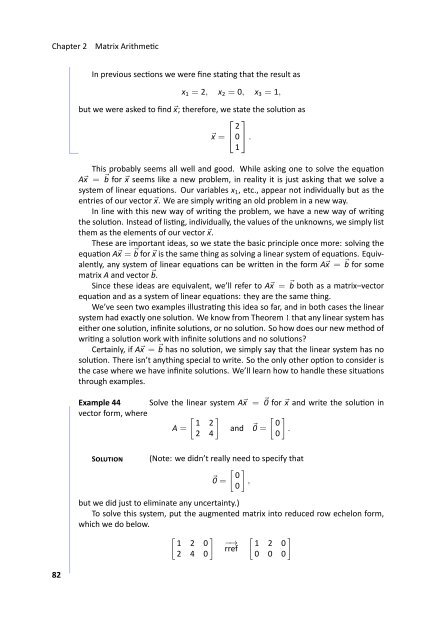Fundamentals of Matrix Algebra, 2011a
Fundamentals of Matrix Algebra, 2011a
Fundamentals of Matrix Algebra, 2011a
You also want an ePaper? Increase the reach of your titles
YUMPU automatically turns print PDFs into web optimized ePapers that Google loves.
Chapter 2<br />
<strong>Matrix</strong> Arithmec<br />
In previous secons we were fine stang that the result as<br />
x 1 = 2, x 2 = 0, x 3 = 1,<br />
but we were asked to find ⃗x; therefore, we state the soluon as<br />
⎡ ⎤<br />
.<br />
⃗x =<br />
⎣ 2 0 ⎦ .<br />
1<br />
This probably seems all well and good. While asking one to solve the equaon<br />
A⃗x = ⃗b for ⃗x seems like a new problem, in reality it is just asking that we solve a<br />
system <strong>of</strong> linear equaons. Our variables x 1 , etc., appear not individually but as the<br />
entries <strong>of</strong> our vector ⃗x. We are simply wring an old problem in a new way.<br />
In line with this new way <strong>of</strong> wring the problem, we have a new way <strong>of</strong> wring<br />
the soluon. Instead <strong>of</strong> lisng, individually, the values <strong>of</strong> the unknowns, we simply list<br />
them as the elements <strong>of</strong> our vector ⃗x.<br />
These are important ideas, so we state the basic principle once more: solving the<br />
equaon A⃗x = ⃗b for⃗x is the same thing as solving a linear system <strong>of</strong> equaons. Equivalently,<br />
any system <strong>of</strong> linear equaons can be wrien in the form A⃗x = ⃗b for some<br />
matrix A and vector ⃗b.<br />
Since these ideas are equivalent, we’ll refer to A⃗x = ⃗b both as a matrix–vector<br />
equaon and as a system <strong>of</strong> linear equaons: they are the same thing.<br />
We’ve seen two examples illustrang this idea so far, and in both cases the linear<br />
system had exactly one soluon. We know from Theorem 1 that any linear system has<br />
either one soluon, infinite soluons, or no soluon. So how does our new method <strong>of</strong><br />
wring a soluon work with infinite soluons and no soluons?<br />
Certainly, if A⃗x = ⃗b has no soluon, we simply say that the linear system has no<br />
soluon. There isn’t anything special to write. So the only other opon to consider is<br />
the case where we have infinite soluons. We’ll learn how to handle these situaons<br />
through examples.<br />
. Example 44 .Solve the linear system A⃗x = ⃗0 for ⃗x and write the soluon in<br />
vector form, where [ ]<br />
[ ]<br />
1 2<br />
0<br />
A = and ⃗0 = .<br />
2 4<br />
0<br />
S<br />
(Note: we didn’t really need to specify that<br />
[ ] 0 ⃗0 = ,<br />
0<br />
but we did just to eliminate any uncertainty.)<br />
To solve this system, put the augmented matrix into reduced row echelon form,<br />
which we do below.<br />
[ 1 2<br />
] 0<br />
2 4 0<br />
−→<br />
rref<br />
[ 1 2<br />
] 0<br />
0 0 0<br />
82

















